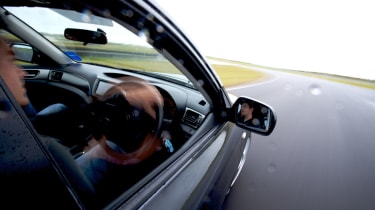Mitsubishi Evo v Subaru Impreza - Subaru Impreza S-GT: Subaru Impreza S-GT
So the new Impreza doesn’t look much. What’s new?
The simple truth is that nobody buys an Impreza for its ravishing lines. No, the Impreza’s appeal lies in what it does, not how it looks when it’s doing it. And if the new hatchback body contains the performance and chassis magic of its predecessors then it’ll soon be adopted by the Subaru hardcore. Perhaps a few newcomers too, or at least that’s Subaru’s plan… The hardcore have every right to feel a little wounded, though. IM Group, who import Subarus into the UK, didn’t intend to bring the turbocharged WRX to these shores at all. It wanted to push the more mainstream (for which read ‘dull’) 1.5R and 2.0R models, and deemed the WRX a sales cul-de-sac. An odd decision considering the turbocharged, rally-influenced models have been the bedrock of Impreza sales in the UK since the early ’90s. Fortunately IM Group relented and you will now be able to buy a WRX, but it will be imported in strictly limited numbers – just 350 in its first year on sale. Eager buyers have other options, though. What you see here is an Impreza S-GT – the Japanese equivalent of the WRX – imported by the ever-enterprising Iain Litchfield of Litchfield Imports. It costs £19,995 (the same as the official UK WRX), has a 260bhp 2-litre twin-scroll turbocharged flat-four (as opposed to the UK WRX’s 227bhp 2.5-litre single-scroll turbo engine), and until the STI arrives in the spring of next year it’s the closest we’ll get to finding out if the Impreza still has the firepower to square-up to the fierce Mitsubishi Evo X. The S-GT doesn’t have Subaru’s ‘Vehicle Dynamics Control’ electronics, which will be standard on all UK and US WRX models. VDC is essentially a sophisticated stability control system that cuts power and applies braking to individual wheels if it senses understeer or oversteer building. The S-GT sticks with a strictly mechanical package, namely a centre differential with viscous coupling and a rear limited-slip diff – all the better, because it ensures that no electronics get in the way of the driving experience. So in effect this is a sort of STI-lite. The full fat, blistered arched, 350bhp STI will be a wilder animal, but these are the foundations. Let’s hope they’re deep and strong… The old Impreza was unfashionably narrow and seemed to be constructed without any concessions to side-impact safety. Of course, this wasn’t actually the case, but the thin doors and slim pillars always made the it feel a generation or two behind something like a BMW. The new car is more substantial. It has filled out in all the right places and overall it looks more expensive and more modern. It’s a credit to Subaru, then, that the new hatch is 15kg lighter than the old saloon. Pull the chunky door handle, drop into the generous sculpted seat and suddenly the aura of quality disappears. The dash is cut from hard plastics and hopelessly outdated. It’s been ‘styled’, but clearly by somebody who buys his clothes at Tesco and loves grey slip-ons. Will Subaru ever get this right? At least the driving position is spot-on – upright and commanding – and the central rev-counter is big and clear. It definitely feels like an Impreza at a standstill. Flick the boxer engine into life and it sounds like an Impreza, too. A little quieter certainly, but the offbeat warble gently percolates through the interior. The five-speed ’box is familiarly sweet, with a long throw and an easy precision. The ride is relaxed, absorbing small imperfections and big undulations decisively. It’s much more pliant than a Golf GTI and a million miles away from the darty, agitated aggression of the Mégane R26. The steering is very light – too light to give you any sense of connection with the front wheels. Combined with the refinement of engine and ride, this all makes for a slightly detached and oddly unsporty first impression. Only the instantly responsive and hugely muscular engine hints at the potential that lies beneath. (This particular S-GT is in fact a development car for Litchfield’s forthcoming ‘Sport’ package and as such is running around 280bhp along with 18in wheels – an inch up on the basic items – but is otherwise standard S-GT.) Turn the wheel in towards an apex, though, and the S-GT really takes notice. That light steering belies a pointy, reactive front end and, although there’s a lot of body roll, the chassis doesn’t feel like it’s struggling to keep pace with the direction change. No, it settles quickly and confidently and grips like an Impreza should. String a few corners together and the composure remains, the car flicking from one direction to the next with a fluid composure and a neutral balance. Throw in some craggy tarmac, compressions and crests and the Impreza digs deep, finding incredible cross-country pace. You never have the feel you want through the steering, but the chassis is so stable that you soon start to work the tyres hard, trusting they’ll grip. It is a strangely schizophrenic arrangement, though, the light steering and soft suspension masking the car’s inherent agility. It’s almost as if body and chassis are connected via a viscous oil, and you’re up in no-man’s-land, lagging behind what’s happening down at the ground. It’s certainly effective, but I’m not sure it’s a huge amount of fun, not if you’re expecting a down-and-dirty, demanding and invigorating hero car. We head to Anglesey Circuit, hoping to find another layer of ability, another dimension to the Impreza’s chassis. It’s damp and drying – conditions that Subarus usually revel in. The first few exploratory laps reveal little more than strong, fade-resistant brakes and a keenness to understeer at the limit. It doesn’t wash wide horribly, but from turn-in to exit the push is consistent and slightly frustrating. I’d hoped the diffs would allow some initial slip and then start to rein things in by the apex, allowing more and more throttle as the corner opens out. Instead the Impreza feels just a bit too safe. Time to up the stakes. Get the nose in earlier and hang on to the brakes on the way in, feeling the rear edge out just a few degrees and help prevent any understeer building, then light-up the turbo and charge onto the next straight. It’s better, but as soon as the initial slip at the rear has died the understeer sets in again. OK, get a bit braver and fling the Impreza at the apex. Now the rear slides well wide. Add some corrective lock and pin the throttle. The slide stabilises then reduces until you’re in a nice four-wheel drift, and you hit the straight hooked-up and carrying more speed than you’d ever manage just by driving smoothly up to the limit. This is more like it. However, the Impreza is pretty edgy when driven like this, certainly less progressive than the old WRX (perhaps because it has more grip) and you’d simply never drive with such abandon on the road. Generally speaking, the S-GT is more nose-led, and less keen to sharpen its line on the throttle. You can get it to play, but only on a really open corner. In slower turns you really feel the more conservative set-up. Try as you might, you can’t kill the understeer and eventually you have to just be patient and nudge up against the limits of the front tyres. So this Impreza is no trackday car, but that’s been true of the WRX for some time. The STI, with its more aggressive diffs, more explosive power and stiffer set-up, should be much more adept at circuit work. What this Impreza is, however, is a stonkingly rapid road car. Subaru has gone its own way with the chassis set-up. It’s not like a Cooper S or a Mégane R26 or an Astra VXR – conventional performance cars. It’s a car with long suspension travel, a car that trades ultimate body control for excellent wheel control on all surfaces, allowing you to use all of its performance all of the time. It has huge potential. Right now it doesn’t really engage the driver, doesn’t get under your skin, and when you’re simply bimbling around it doesn’t feel special like the old WRX. The STI will need to be a heap more exciting, but the S-GT’s pace and stability suggest that the Evo won’t have it all its own way.
Specifications
| Engine | Flat-four, turbo |
| Location | Front, longitudinal |
| Displacement | 1994cc |
| Bore x stroke | 92 x 75mm |
| Cylinder block | Aluminium alloy |
| Cylinder head | Aluminium alloy, dohc, 4v per cylinder, variable valve timing |
| Fuel and ignition | Electronic engine management, multipoint injection |
| Max power | 260bhp @ 6000rpm |
| Max torque | 250lb ft @ 2800rpm |
| Transmission | Five-speed manual, four-wheel drive, viscous centre differential, limited-slip rear differential |
| Front suspension | MacPherson struts, coil springs, dampers, anti-roll bar |
| Rear suspension | Multi-link, coil springs, dampers, anti-roll bar |
| Brakes | Discs front and rear, EBD, ABS |
| Wheels | 7 x 17in front and rear (7.5 x 18in as tested) |
| Tyres | 205/50 R17 Bridgestones (225/40 ZR18 Michelins as tested) |
| Weight (kerb) | 1395kg |
| Power-to-weight | 189bhp/ton |
| 0-62mph | 5.5sec (claimed) |
| Max speed | 146mph (claimed) |
| Basic price | £19,995 (see text) |
| On sale | Now |
| evo rating | 3.5/5 |




